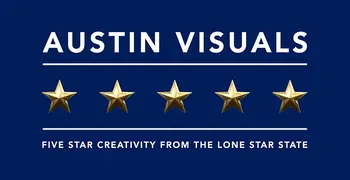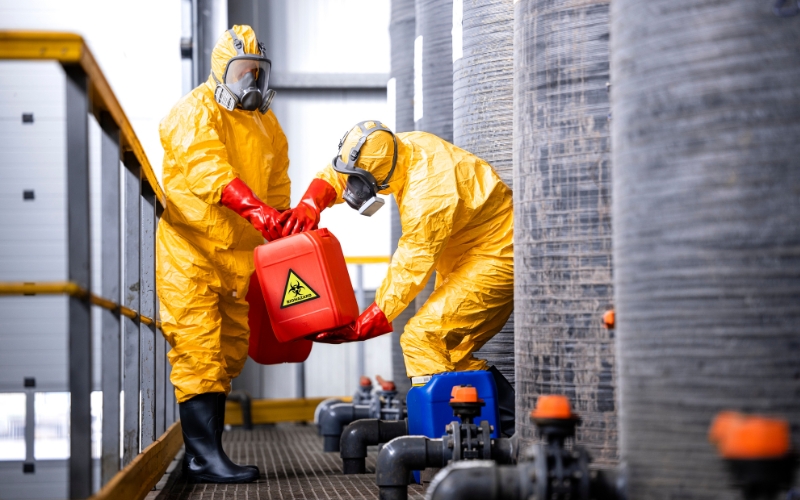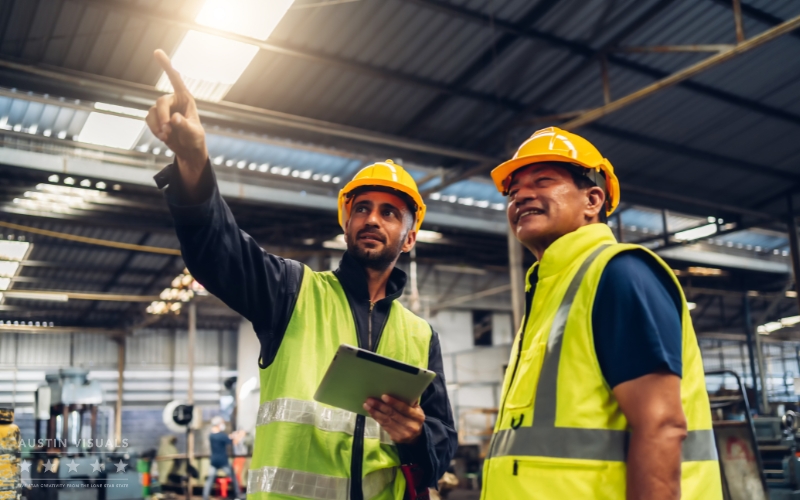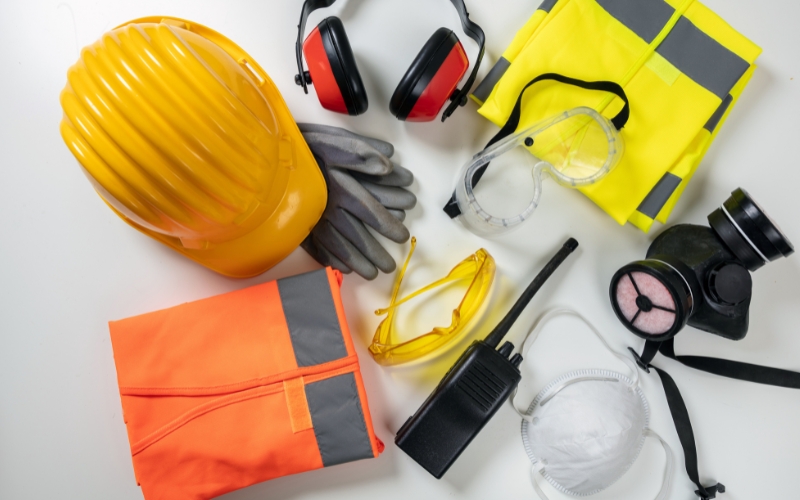
Introduction
Workplace safety is a top priority in the manufacturing industry, where employees often operate heavy machinery, handle hazardous materials, and work in environments with potential risks. While companies implement safety protocols to protect workers, accidents can still occur due to inadequate training, miscommunication, or lack of awareness.
Ensuring employees understand and follow safety procedures is crucial to preventing injuries, minimizing downtime, and maintaining compliance with safety regulations. One of the most effective ways to achieve this is through manufacturing safety videos, which provide visual, engaging, and repeatable training for employees.
The Importance of Safety in Manufacturing
Common Hazards in Manufacturing Workplaces
Manufacturing environments expose employees to various risks. Identifying these hazards and implementing proper training reduces workplace incidents.
Machinery-Related Accidents
Operating heavy machinery without adequate training can lead to severe injuries. Common risks include:
- Improper machine guarding, leading to accidental contact with moving parts.
- Lack of lockout/tagout procedures, increasing the risk of electrocution or machine activation during maintenance.
- Inadequate operator training, resulting in misuse of equipment.
How safety videos help: Training videos demonstrate proper machine usage, highlighting real-world scenarios and best practices. Employees can see step-by-step instructions on operating and maintaining equipment safely.
Chemical Exposure Risks
Many manufacturing processes involve hazardous substances, including toxic fumes, combustible chemicals, and corrosive materials. Risks include:
- Improper handling leading to spills, fires, or chemical burns.
- Lack of personal protective equipment (PPE), increasing exposure risks.
- Insufficient training on emergency response in case of spills or leaks.
How safety videos help: Chemical safety training videos illustrate proper handling, storage, and emergency response procedures, ensuring employees understand necessary precautions.
Slips, Trips, and Falls
Slips, trips, and falls are among the most common workplace accidents, often caused by:
- Wet or uneven surfaces.
- Poor lighting in work areas.
- Improper use of ladders and scaffolding.
How safety videos help: Animated safety videos effectively demonstrate hazard recognition, proper footwear usage, and fall prevention techniques.
Fire and Electrical Hazards
Fires and electrical malfunctions can cause severe damage and endanger employees. Risks include:
- Overloaded circuits and improper wiring.
- Poorly maintained equipment leading to electrical shorts.
- Failure to follow fire safety protocols.
How safety videos help: Safety animations break down fire prevention measures and electrical safety guidelines, ensuring employees know how to handle fire hazards.
Impact of Workplace Accidents
The consequences of workplace accidents extend beyond immediate injuries. Understanding these impacts reinforces the need for effective safety training.
Injuries and Loss of Workforce Productivity
When employees suffer injuries, businesses face reduced productivity due to:
- Absenteeism and lost workdays.
- Increased workload on remaining staff.
- Disruptions in production schedules.
Financial Costs of Workplace Accidents
Workplace accidents lead to financial burdens, including:
- Workers’ compensation claims.
- Increased insurance premiums.
- Equipment damage and repair costs.
Legal and Compliance Implications
Failing to meet safety regulations can result in severe penalties, including:
- OSHA fines and legal consequences.
- Liability lawsuits from injured employees.
- Damage to company reputation and loss of trust.
How safety videos help: By providing consistent and clear safety training, manufacturing safety videos reduce accidents, improve compliance, and protect employees.
How Safety Videos Improve Workplace Safety
Engaging and Effective Training
Employees learn best when training materials are engaging and easy to understand. Traditional safety training methods often fall short, leading to gaps in knowledge. Manufacturing safety videos improve learning outcomes through:
How Visual Learning Improves Retention
Studies show that people remember 80% of what they see, compared to just 20% of what they read. Safety videos provide:
- Step-by-step demonstrations of procedures.
- Realistic scenarios that employees can relate to.
- Animated explanations of complex safety concepts.
Real-World Scenarios in Safety Animations
Safety videos can recreate real workplace scenarios, helping employees understand:
- How to react in emergency situations.
- Proper procedures for operating equipment.
- Consequences of failing to follow safety protocols.
Benefits Over Traditional Training Methods
Unlike paper manuals or one-time lectures, safety videos:
- Are available on demand, allowing employees to review training anytime.
- Provide visual consistency, ensuring all employees receive the same quality training.
- Can be updated easily to reflect new safety regulations.
Ensuring Consistent Safety Messaging
Ensuring every employee receives the same high-quality training is a challenge, especially in large manufacturing companies. Manufacturing safety videos help maintain consistency through:
Standardizing Training Across Multiple Locations
For businesses with multiple facilities, training consistency is crucial. Safety videos:
- Deliver uniform safety messages to all employees.
- Eliminate inconsistencies caused by different trainers.
- Provide repeatable training sessions for new hires.
Reducing Human Error in Safety Instruction
Human trainers may unintentionally omit critical safety details. Safety videos eliminate this risk by providing structured, error-free guidance every time.
Reinforcing Best Practices Regularly
Employees can forget safety protocols over time. Safety videos serve as regular refreshers, reinforcing:
- Proper use of PPE.
- Equipment handling procedures.
- Emergency response plans.
By implementing manufacturing safety videos, businesses improve employee retention of safety guidelines, reduce errors, and create a safer work environment.
Types of Manufacturing Safety Videos
Equipment Safety Training Videos
Manufacturing environments often involve the use of complex machinery, which, if operated incorrectly, can pose serious risks. Equipment safety training videos are designed to help employees understand the correct operation and maintenance of machines, reducing the likelihood of accidents.
Proper Machine Operation Procedures
Every machine has specific operating guidelines to ensure safe and efficient performance. Training videos break down these procedures in a step-by-step format, allowing employees to:
- Learn how to start, operate, and shut down machinery safely.
- Understand the importance of inspections before use to check for potential issues.
- Recognize warning signs that indicate malfunctioning equipment.
Lockout/Tagout (LOTO) Protocols
Lockout/Tagout (LOTO) procedures are essential for preventing unintended machine activation during maintenance. Without proper LOTO training, employees may suffer electrocution, crushing injuries, or other severe accidents. Safety videos can demonstrate:
- When and how to apply lockout/tagout devices correctly.
- Steps to follow before performing maintenance or servicing.
- The dangers of bypassing LOTO procedures and the potential consequences.
Preventive Maintenance Guidance
Regular maintenance prevents machinery malfunctions and extends equipment lifespan. Training videos on preventive maintenance can help employees:
- Identify routine maintenance tasks required for specific machines.
- Recognize signs of wear and tear that require attention.
- Follow safe procedures for performing maintenance and reporting equipment issues.
Hazard Communication and Chemical Safety Videos
Many manufacturing facilities handle chemicals that pose risks such as toxic exposure, burns, or explosions. Employees must be trained to identify and manage hazardous substances safely.
Understanding Safety Data Sheets (SDS)
Safety Data Sheets (SDS) contain important information about chemical properties, hazards, and handling procedures. Training videos help employees:
- Understand how to read and interpret SDS documents correctly.
- Identify the potential risks associated with different chemicals.
- Follow recommended safety measures when using hazardous substances.
Safe Handling of Hazardous Materials
Manufacturing safety videos demonstrate best practices for storing, transporting, and using hazardous materials, including:
- Proper labeling and storage to prevent cross-contamination.
- The importance of wearing appropriate personal protective equipment (PPE).
- Procedures for mixing and disposing of chemicals safely.
Emergency Response Protocols
In case of a chemical spill, leak, or exposure, employees must know how to respond quickly. Safety videos can illustrate:
- Immediate decontamination steps for exposed employees.
- The correct use of emergency eyewash stations and showers.
- How to contain and report spills to prevent workplace hazards.
Personal Protective Equipment (PPE) Training
Personal protective equipment (PPE) is the first line of defense against workplace hazards. However, improper use or neglect of PPE can lead to injuries, contamination, or long-term health issues.
Importance of PPE Compliance
Employers must ensure that all employees understand the necessity of wearing PPE. Training videos emphasize:
- Why PPE is required for specific job roles and tasks.
- The dangers of working without proper protection.
- How PPE reduces exposure to hazards such as chemical splashes, flying debris, or high noise levels.
Proper Use of Helmets, Gloves, Eye Protection, and More
Each type of PPE has specific guidelines for proper use. Safety videos provide demonstrations on:
- Selecting the right PPE based on job requirements.
- How to wear and adjust PPE for maximum protection.
- Inspecting PPE for damage before and after use.
Common PPE Mistakes and How to Avoid Them
Employees sometimes make critical mistakes when using PPE, reducing its effectiveness. Training videos highlight common errors, such as:
- Wearing loose-fitting gloves or improperly secured helmets.
- Forgetting to replace damaged PPE.
- Not using safety glasses or face shields when required.
Emergency Preparedness and Response Videos
Emergencies such as fires, accidents, or medical crises can occur at any time in a manufacturing facility. Employees must be trained to respond effectively to minimize risks and save lives.
Fire Safety and Evacuation Procedures
Manufacturing environments often contain flammable materials and electrical equipment, increasing fire risks. Safety videos help employees:
- Identify fire hazards in the workplace.
- Learn how to use fire extinguishers correctly.
- Follow evacuation procedures to exit the facility safely.
First Aid and Injury Response
Immediate first aid can prevent minor injuries from becoming severe. Safety videos teach employees how to:
- Administer CPR and basic first aid.
- Treat cuts, burns, or fractures before medical help arrives.
- Use first aid kits and emergency response equipment properly.
Crisis Management and Reporting
When an emergency occurs, employees need to act fast and report incidents correctly. Training videos demonstrate:
- How to communicate emergencies to supervisors or first responders.
- The importance of documenting accidents for safety improvements.
- Procedures for handling workplace violence or security threats.
Key Features of Effective Manufacturing Safety Videos
Not all safety videos are equally effective. To maximize learning and compliance, training videos must be designed with clarity, relevance, and regulatory adherence in mind.
Clear and Concise Messaging
Avoiding Technical Jargon for Better Understanding
Safety videos should simplify complex topics so that employees of all skill levels can understand them. This means:
- Using plain language instead of technical terms.
- Avoiding overly detailed explanations that cause confusion.
- Focusing on essential safety takeaways.
Using Step-by-Step Explanations
A structured approach makes safety training more effective. Videos should:
- Break down processes into simple steps.
- Highlight key actions with visuals and text overlays.
- Include reinforcement questions to improve retention.
Realistic Scenarios and Demonstrations
Animations vs. Live-Action Safety Demonstrations
Both animated and live-action safety videos have benefits:
- 3D animations can illustrate complex machinery processes that may be difficult to capture in real life.
- Live-action demonstrations help employees connect with real workplace situations.
- Hybrid videos combine both elements for maximum engagement.
Importance of Relatable Workplace Situations
Employees engage better with training videos that reflect their actual work environment. Effective safety videos:
- Show realistic manufacturing settings.
- Feature scenarios based on past incidents.
- Use role-playing exercises to reinforce key points.
Compliance with Industry Regulations
Meeting OSHA and Industry-Specific Safety Standards
Many industries have strict safety regulations that must be followed. Safety videos should:
- Include up-to-date OSHA guidelines and other regulatory standards.
- Address specific industry risks (e.g., heavy machinery, chemical handling).
- Provide documentation for compliance training.
How Compliance-Focused Videos Reduce Legal Risks
Failing to meet safety standards can result in:
- Fines and penalties from OSHA or other agencies.
- Increased liability in workplace injury lawsuits.
- Higher insurance costs due to non-compliance.
By ensuring employees receive proper safety training, businesses can reduce risks, improve compliance, and create a safer work environment.
Why Choose Professional Safety Video Production?
Expertise in Manufacturing and Industrial Safety
Not all training videos are created equal. The most effective manufacturing safety videos are developed by specialists with deep knowledge of workplace safety protocols and industrial regulations.
How Industry Specialists Create Effective Training Content
A professional safety video production team works closely with manufacturing companies to ensure that the training content is:
- Accurate – Based on the latest safety regulations and best practices.
- Engaging – Designed to keep employees focused and interested.
- Actionable – Providing clear guidance on how to avoid workplace hazards.
Customizing Safety Videos for Specific Workplace Needs
Every manufacturing facility has unique safety challenges, and generic training content may not be sufficient. A professional production team can:
- Identify workplace-specific risks and create targeted training solutions.
- Adapt training materials for different job roles (machine operators, supervisors, maintenance staff, etc.).
- Develop multilingual videos to accommodate diverse workforces.
Custom safety videos ensure that employees receive relevant, job-specific training that applies directly to their work environment.
High-Quality Animation for Better Engagement
Traditional safety training methods often rely on static images or lengthy explanations that fail to capture attention. 3D animations and motion graphics bring safety concepts to life, making training more engaging and easier to understand.
Using 3D Animations to Visualize Complex Safety Procedures
Many manufacturing processes involve technical procedures and complex machinery that can be difficult to explain through text alone. High-quality 3D animations can:
- Demonstrate machine operation step-by-step in a clear, visual format.
- Show internal machine mechanisms that would otherwise be impossible to illustrate.
- Depict hazardous scenarios safely, without putting real employees at risk.
Advantages of Animation Over Traditional Training Methods
- Improved retention – Employees remember visual information more effectively than text-based training.
- Consistency – Unlike in-person training, animated videos ensure that every employee receives the same information.
- Scalability – Videos can be shared across multiple locations without additional instructor costs.
By investing in professionally produced safety videos, manufacturing companies can create training materials that are both educational and engaging, improving safety compliance across the workforce.
Cost-Effective and Scalable Training Solutions
Many companies hesitate to invest in professional safety video production due to perceived costs. However, custom safety videos provide long-term savings by reducing training expenses, minimizing workplace incidents, and ensuring regulatory compliance.
Reducing Long-Term Training Costs
- One-time production investment – Unlike live training sessions that require ongoing expenses (trainers, travel, printed materials), safety videos can be used repeatedly without additional costs.
- Lower injury-related expenses – Effective training helps prevent accidents, reducing workers’ compensation claims and medical costs.
- Increased employee productivity – Well-trained workers make fewer errors and require less supervision.
Easy Updates for Changing Safety Regulations
Regulatory requirements and safety protocols evolve over time. With professional video production, companies can:
- Easily update specific sections of training videos to reflect new regulations.
- Adapt content as new equipment or processes are introduced.
- Ensure compliance with OSHA and industry-specific standards without overhauling the entire training program.
Professional manufacturing safety videos offer a cost-effective, scalable solution for improving workplace safety, reducing liability, and maintaining compliance.
Partner with Austin Visuals for Your Manufacturing Safety Videos
Austin Visuals 3D Animation Studio specializes in producing high-quality safety training videos tailored to the unique needs of manufacturing, industrial, and construction companies. Our expertise in 3D animation, live-action training videos, and interactive e-learning content ensures that businesses receive training materials that are both effective and engaging.
Custom Safety Video Solutions for Manufacturing Companies
Unlike generic training videos, Austin Visuals creates fully customized safety content based on each company’s specific needs. Our team works closely with clients to:
- Identify workplace hazards and determine key training priorities.
- Develop tailored video content that aligns with OSHA and industry safety regulations.
- Incorporate real-world scenarios to improve employee engagement and retention.
Our safety videos include:
✅ Equipment operation and maintenance training
✅ Personal protective equipment (PPE) compliance
✅ Emergency response and evacuation procedures
✅ Hazard communication and chemical safety training
✅ Workplace ergonomics and injury prevention
By offering customized safety video solutions, we help manufacturing companies enhance training effectiveness and reduce workplace incidents.
Why Companies Trust Austin Visuals
Austin Visuals has a proven track record in safety video production, serving businesses across various industries, including manufacturing, construction, energy, and healthcare. Our clients trust us because we offer:
✅ Expertise in workplace safety – We understand manufacturing risks and create content that meets safety compliance requirements.
✅ High-quality animation and visuals – Our professional 3D animations make complex safety topics easy to understand.
✅ Custom training solutions – We work with businesses to develop videos tailored to their specific safety concerns.
✅ Interactive and engaging content – Our videos keep employees engaged, improving learning retention and compliance.
Manufacturers and industrial companies rely on Austin Visuals to improve safety culture, reduce accidents, and streamline training programs with professional safety videos.
Get Started with Professional Safety Video Production
Are you ready to enhance your manufacturing safety training with high-quality videos? Austin Visuals makes the process simple and efficient.
Contact Us Today :
📞 Call us at: 512-591-8028024
📧 Email us at: [email protected]
Next Steps for Implementing Safety Training Videos
1️⃣ Schedule a free consultation – Discuss your company’s safety training needs with our experts.
2️⃣ Develop a customized video strategy – Our team will create tailored content that aligns with your safety goals.
3️⃣ Receive high-quality safety training videos – Enhance employee training and compliance with engaging, effective video content.
Invest in workplace safety today with Austin Visuals. Let’s work together to create a safer, more compliant manufacturing environment with professional safety videos.








